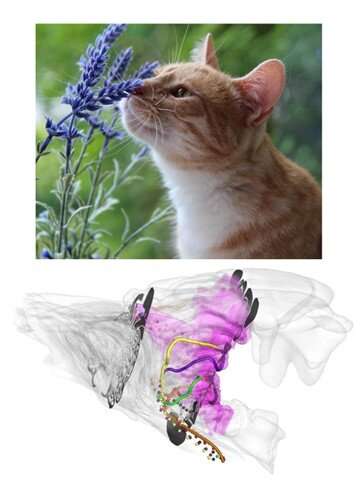This article has been reviewed according to Science X's editorial process and policies. Editors have highlighted the following attributes while ensuring the content's credibility:
fact-checked
peer-reviewed publication
trusted source
proofread
Domestic cats' noses may function like highly efficient gas chromatographs

Scientists have found the secret to felines' finesse at sniffing out food, friends and foes. A complex collection of tightly coiled bony airway structures gets the credit, according to the first detailed analysis of the domestic cat's nasal airway.
The researchers created a 3D computer model of the cat nose and simulated how an inhalation of air containing common cat food odors would flow through the coiled structures. They found that the air separates into two flow streams, one that is cleansed and humidified and another delivering the odorant quickly and efficiently to the system responsible for smelling—the olfactory region.
In essence, the researchers suggest, the cat nose functions as a highly efficient and dual-purposed gas chromatograph—a tool that, in the laboratory, detects and separates chemicals in vaporized form. In fact, the cat nose is so efficient at this that its structure could inspire improvements to the gas chromatographs in use today. The research is published in PLOS Computational Biology.
While the long alligator nose has also been found to mimic gas chromatography, researchers theorize that the compact cat head drove an evolutionary change that resulted in the labyrinthine airway structure that not only fits, but helps cats adapt to diverse environments.
"It's a good design if you think about it," said Kai Zhao, associate professor of otolaryngology in Ohio State's College of Medicine and senior author of the study.
"For mammals, olfaction is very important in finding prey, identifying danger, finding food sources and tracking the environment. In fact, a dog can take a sniff and know what has passed through—was it a friend or not?" he said. "That's an amazing olfactory system—and I think potentially there have been different ways to evolve to enhance that.
"By observing these flow patterns and analyzing details of these flows, we think they could be two different flow zones that serve two different purposes."
Zhao's lab has previously created models of the rat and human nose to study air flow patterns, but the high-resolution cat model and simulation experiments are his most complicated to date, based on micro-CT scans of a cat's head and microscopic-level identification of tissue types throughout the nasal cavity.
"We spent a lot of time developing the model and more sophisticated analysis to understand the functional benefit that this structure serves," he said. "The cat nose probably has a similar complexity level as the dog's, and it's more complex than a rodent's—and it begs the question—why was the nose evolved to be so complex?"
Computer simulations of breathing revealed the answer. During a simulated inhalation, researchers observed two distinct regions of air flow—respiratory air that gets filtered and spreads slowly above the roof of the mouth on its way to the lungs, and a separate stream containing odorant that moves rapidly through a central passage directly to the olfactory region toward the back of the nasal cavity. The analysis took into account both the location of flow and the speed of its movement through turbinates, the bony structures inside the nose.
"We measured how much flow goes through specific ducts—one duct that delivers most odorant chemicals into the olfactory region, versus the rest, and analyzed the two patterns," Zhao said. "For respirant breathing, turbinates branch to divert flow into separate channels, sort of like a radiator grid in a car, which would be better for cleansing and humidifying.
"But you want odor detection to be very fast, so there is one branch that delivers odor at high speed, potentially allowing for quick detection rather than waiting for air to filter through the respiratory zone—you could lose most of the odor if air has been cleansed and the process is slowed down."
The simulation also showed that the air shuttled to the olfactory region is then recirculated in parallel channels when it gets there. "That was actually a surprise," Zhao said. "It's like you take a sniff, the air is shooting back there and then is being processed for a much longer time."
This study is the first to quantify the difference in gas chromatography between mammals and other species—Zhao and colleagues estimate the cat's nose is more than 100 times more efficient at odor detection than an amphibian-like straight nose in a similarly sized skull—and to come up with a parallel gas chromatography theory: parallel olfactory coils feeding from the high-speed stream to increase the effective length of the flow path while slowing down the local airflow speed, potentially for better odor processing.
"We know so much about vision and hearing, but not so much about the nose. This work could lead to more understanding of the evolutionary pathways behind different nose structures, and the functional purpose they serve," Zhao said.
Zhenxing Wu, a postdoctoral scholar in Zhao's lab, is first author of the study. Additional co-authors include Jianbo Jiang and Fritz Lischka of Monell Chemical Senses Center in Philadelphia; Scott McGrane of Waltham Petcare Science Institute in the United Kingdom; and Yael Porat-Mesenco of the University of Pennsylvania.
More information: Wu Z, Jiang J, Lischka FW, McGrane SJ, Porat-Mesenco Y, Zhao K. Domestic cat nose functions as a highly efficient coiled parallel gas chromatograph, PLoS Computational Biology (2023). DOI: 10.1371/journal.pcbi.1011119. journals.plos.org/ploscompbiol … journal.pcbi.1011119
Journal information: PLoS Computational Biology
Provided by The Ohio State University



















